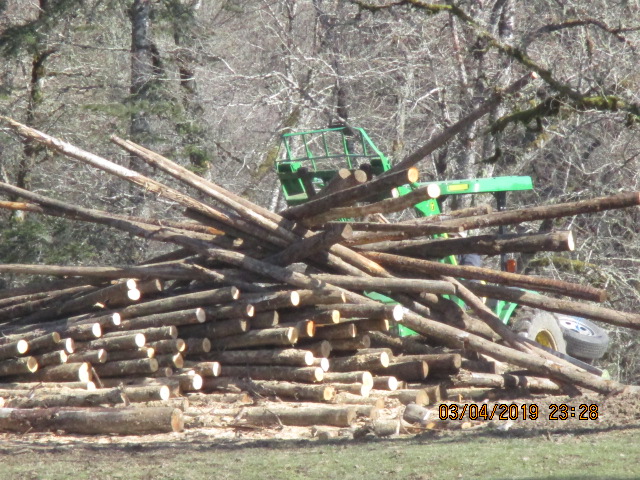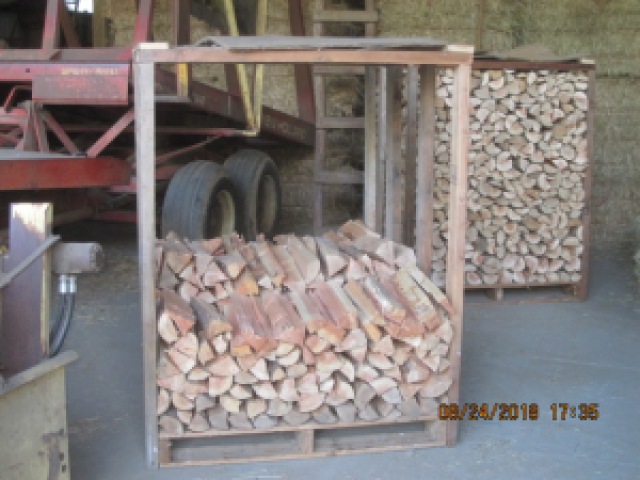Think You Can Wood 2
Part 2 in a series of stories about our farm, the firewood production project and our involvement with Oregon Woodland Coop. In Part 1 you heard about the history of the property, logging and planting protocols.
Story 2- Assessing capabilities
Our farm is tucked into the Coast Range of the Pacific Northwest. Most of the flat ground on the property is in hay fields, open range areas for the herd of Black Angus cattle, the Nehalem River and riparian areas. Most of the forestland on the property is uphill from the fields, steep uphill. The top of the ridge is over 800 feet higher than the elevation at river level. One of the biggest challenges we have in the firewood production project is ability to have wood available to process when we need it.
With the small logging jobs we have during the summer months, we generate truckloads of pulp (small trees and tops not large enough to go to timber mills). Besides the pulp wood, we have so much more that is too small or short to fit onto a log truck so it cannot be shipped to the pulp mill.
Although we are not necessarily opposed to burning piles of slash (the pieces that are too small for pulp, branches and debris), we do not like to burn in our forest for the simple fact that we cannot get into the forest easily in the winter time when burning should be taking place. The logging road up to the forest is inaccessible because of the steepness and it is not rocked so the only access by vehicle is during the dry summer months. Entry to the forest during the wet season and winter months from our property can be made on foot only. We choose to use our energy in making the uphill climb for recreation like hunting, mushroom harvesting and tree planting rather than on building and tending fires.
With our supply being ‘up there’, the wood needs to be brought down the hill to landings in the late summer. Our logging dozer is equipped with six cable chokers. Each choker can encircle up to five trees at a time. A single trip down the hill can yield thirty trees. With some of the small diameter trees stretching out 40 feet or more, the pile in the landing can fill up quickly.
2018 was our first year of stockpiling the wood in the landing at the bottom of the hill to be processed into firewood for the OWC, our home use, friends and family. We estimated the volume to be the equivalent of three log truckloads of wood equaling out to about 30 cord of processed firewood. Confident that we had the supply of wood needed for our firewood bundling project, the next step was to determine how to season and store the wood as it is made into 16 inch pieces.
Oregon regulations require six months minimum for wood to be seasoned with less than 18% moisture. Wood that was already seasoned and below 18% (dead standing trees or trees that had been in the landing since the year before), were cut, split and stacked directly into the farm truck with a dump bed. This truck is not used in the winter time and would sit idle in the barn so we used that space for wood that was ready to bundle. The truck bed holds 5 cord of firewood and as we use off the back the dump bed since it can be lifted and the wood pieces drop to the back in easy reach to bundle.
For the wood that needed to season, Mike used pallets to form cribs to hold the split pieces as they cured and dried. The lumber for the cribs was salvaged from tearing down the old house 10 years ago that stood on the property. With the salvaged wood, nails and screws, Mike made eight cribs. Each crib holds a half-cord of firewood with the 16 inch pieces fitting into three rows with a bit of space available for air circulation during the drying process.
Once the firewood pieces are stacked into the crib for drying and seasoning, they need to be placed in a safe place. Our herd of cattle are used to wide open areas in which to graze during the summer months after the hay has been harvested, this includes the areas around the barns and landings. If we filled a crib with firewood and left it in the sunshine to season, the cattle would claim the crib as a scratching post. It would not last long before the structure and wood pieces would be nothing more than a heap on the ground. To ensure the firewood pieces stay clean, we move the filled cribs into the storage area of the barn away from the cattle as soon as we fill them. The wood cures naturally and the cows are not able to disturb the crib or the wood. We use the front loader tractor with pallet forks to move the cribs inside for the drying process.
With the wood available, the sawing in full swing and curing taking place, we needed to learn how to process the seasoned firewood into those neat bundles that you see in the grocery store. It didn’t take many questions before the Oregon Woodland Coop members started offering that we tour their properties and see first-hand how they process their wood.
Stay tuned for the next installment in the Series, So You Think You Can Wood


